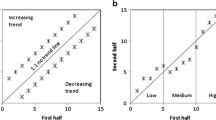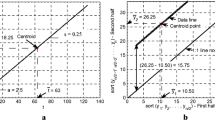Abstract
Hydro-meteorological time series may include trend components mostly due to climate change since about three to four decades. Trend detection and identification in a better and refined manner are among the major current research topics in water resources domain. Even though different methodologies can be found for trend detection in literature, two well-known procedures are the Mann-Kendall (MK) trend test and recently innovative-Şen trend method, which provides different aspects of the trend. The theoretical basis and application of these two methods are completely different. The MK test gives a holistic monotonic trend without any categorization of the time series into a set of clusters, but the innovative-Şen method is based on cluster and provides categorical trend behavior in a given time series. The main purpose of this paper is to provide important differences between these two approaches and their possible similarities. The applications of the two approaches are given for hydro-meteorological records including relative humidity, temperature, precipitation and runoff from Ergene drainage basin in the north-western part of Turkey. It is observed that although MK trend test does not show significant trend almost in all the cases, the innovative-Şen approach yields trend categorizations as “very low”, “low”, “medium” “high” and “very high”, which should be taken into consideration in future flood (“very high”) and drought (“very low”) studies.




Similar content being viewed by others
References
Bezak N, Brilly M, Šraj M (2014) Flood frequency analyses, statistical trends and seasonality analyses of discharge data: a case study of the litija station on the Sava river. J Flood Risk Manag. doi:10.1111/jfr3.12118
Biswas S (2003) Groundwater direction and long-term trend of water level of Nadia district west bengal a statistical analysis. J Geol Soc India 61:22–36
Cheo AE (2016) Understanding seasonal trend of rainfall for the better planning of water harvesting facilities in the Far-North region, Cameroon. Water Utility J 13:3–11
Cong Z, Yang D, Gao B, Yang H, Hu H (2009) Hydrological trend analysis in the yellow river basin using a distributed hydrological model. Water Resour Res 45:W00A13
Çeribaşı G, Doğan E, Sönmez O (2013) Evaluation of sakarya river streamflow and sediment transport with rainfall using trend analysis. Fresenius Environ Bull 22(3A):846–852
Da Silva RM, Santos CAG, Moreira M, Corte-Real J, Silva VCL, Medeiros IC (2015) Rainfall and river flow trends using Mann–Kendall and Sen’s slope estimator statistical tests in the cobres river basin. Nat Hazards 77:1205–1221
Douglas EM, Vogel RM, Kroll CN (2000) Trends in floods and low flows in the United States: impact of spatial correlation. J Hydrol 240:90–105
Eregno FE, Nilsen V, Seidu R, Heistad A (2014) Evaluating the trend and extreme values of faecal indicator organisms in a raw water source: a potential approach for watershed management and optimizing water treatment practice. Environ Prog 1:287–309
Feidas H, Noulopoulou C, Makrogiannis T, Bora-Senta E (2007) Trend analysis of precipitation time series in Greece and their relationship with circulation using surface and satellite data: 1955–2001. Theor Appl Climatol 87(1–4):155–177
Gebremicael TG, Mohamed YA, Betrie GD, van der Zaag P, Teferi E (2013) Trend analysis of runoff and sediment fluxes in the Upper Blue Nile basin: A combined analysis of statistical tests, physically-based models and land use maps. J Hydrol 482:57–68
Güçlü YS, Şişman E, Yeleğen MÖ (2016) Climate change and frequency-intensity-duration (FID) curves for florya station istanbul. J Flood Risk Manag. doi:10.1111/jfr3.12229
Haan CT (1977) Statistical methods in hydrology. The Iowa State University Press, Ames
Haktanir T, Citakoglu H (2014) Trend, independence, stationarity, and homogeneity tests on maximum rainfall series of standard durations recorded in Turkey. J Hydrol Eng 19(9):05014009
Hamed KH, Rao AR (1998) A modified Mann-Kendall trend test for auto correlated data. J Hydrol 204:182–196
Helsel DR, Hirsch RM (2002) Statistical methods in water resources. Chapter A3, techniques of water resources investigations, book 4. U.S. Geological Survey, Shenandoah
Jaiswal RK, Lohani AK, Tiwari HL (2015) Statistical analysis for change detection and trend assessment in climatological parameters. Environ Prog 2(4):729–749
Kendall MG (1975) Rank correlation methods. Charless Griffin, London
Kliment Z, Matouskova M, Ledvinka O, Kralovec V (2011) Trend analysis of rainfall-runoff regimes in selected headwater areas of the Czech Republic. J Hydrosci Hydraul Eng 59(1):36–50
Lehmann EL (1975) Nonparametrics, statistical methods based on ranks. Holden-Day Inc, California
Liu XM, Zhang D (2013) Trend analysis of reference evapotranspiration in northwest China: the roles of changing wind speed and surface air temperature. Hydrol Process 27(26):3941–3948
Mann HB (1945) Nonparametric tests against trend. Econometrica 13:245–259
Markus M, Demissie M, Short M, Verma S, Cooke R (2014) Sensitivity analysis of annual nitrate loads and the corresponding trends in the Lower Illinois river. J Hydrol Eng 19(3):533–543
Mishra A, Coulibaly P (2014) Variability in Canadian Seasonal Streamflow Information and Its Implication for Hydrometric Network Design. J Hydrol Eng 10.1061/(ASCE)HE.1943-5584.0000971, 05014003
Morin E (2011) To know what we cannot know: global mapping of minimal detectable absolute trends in annual precipitation. Water Resour Res 47, W07505
Murdoch PS, Shanley JB (2006) Detection of water quality trends at high, median, and low flow in a Catskill Mountain stream, New York, through a new statistical method. Water Resour Res 42, W08407
Proutsos N, Tsagari K, Karetsos G, Liakatas A, Kritikos TH (2010) Recent temperature over mountainous Greece. Eur Water Manag 32:15–23
Saplioglu K, Kilit M, Yavuz BK (2014) Trend analysis of streams in the western Mediterranean basin of Turkey. Fresenius Environ Bull 23(1A):313–324
Selek B, Tuncok IK (2014) Effects of climate change on surface water management of Seyhan basin, Turkey. Environ Ecol Stat 21(3):391–409
Sen PK (1968) Estimates of the regression coefficient based on Kendall’s tau. J Am Stat Assoc 63:1379–1389
Shadmani M, Marofi S, Roknian M (2012) Trend Analysis in reference evapotranspiration using Mann-Kendall and Spearman’s Rho tests in arid regions of Iran. Water Resour Manag 26(1):211–224
Sonali P, Kumar Nagesh D (2013) Review of trend detection methods and their application to detect temperature changes in India. J Hydrol 476:212–227
Şen Z (2002) Statistic data processing (in Turkish). Turkish Water Foundation, Istanbul
Şen Z (2012) Innovative trend analysis methodology. J Hydrol Eng 17(9):1042–1046
Şen Z (2014) Trend identification simulation and application. J Hydrol Eng 19(3):635–642
Tabari H, Nikbakht J, Hosseinzadeh Talaee P (2012) Identification of trend in reference evapotranspiration series with serial dependence in Iran. Water Resour Manag 26(8):2219–2232
Timbadiya P, Mirajkar A, Patel P, Porey P (2013) Identification of trend and probability distribution for time series of annual peak flow in Tapi Basin, India. ISH Int J Hydrocarb Eng 19(1):11–20
Wu H, Soh LK, Samal A, Chen XH (2008) Trend analysis of streamflow drought events in Nebraska. Water Resour Manag 22:145–164
Yavuz H, Erdoğan S (2012) Spatial analysis of monthly and annual precipitation trends in Turkey. Water Resour Manag 26(3):609–621
Yin YH, Wu SH, Chen G, Dai EF (2010) Attribution analyses of potential evapotranspiration changes in China since the 1960s. Theor Appl Climatol 101(1–2):19–28
Acknowledgments
In this study the first and last authors are supported by The Scientific and Technological Research Council of Turkey (TUBITAK) with grand numbers 1059B141501044 and 1059B141501090 respectively. The authors would like to thank TUBITAK for the support of this study. Also, the authors wish to thank Turkish State Meteorological Service (TSMS) for the supply of long-term monthly mean climatic variables and General Directorate of State Hydraulic Works (DSI) for sharing flow data in Ergene Basin.
Author information
Authors and Affiliations
Corresponding author
Rights and permissions
About this article
Cite this article
Dabanlı, İ., Şen, Z., Yeleğen, M.Ö. et al. Trend Assessment by the Innovative-Şen Method. Water Resour Manage 30, 5193–5203 (2016). https://doi.org/10.1007/s11269-016-1478-4
Received:
Accepted:
Published:
Issue Date:
DOI: https://doi.org/10.1007/s11269-016-1478-4




